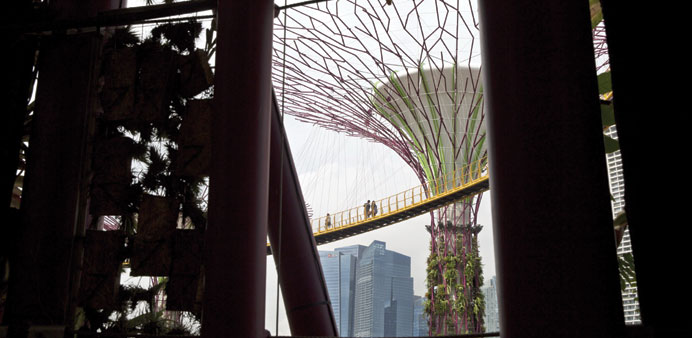People walk along an elevated walkway past solar-powered ‘Supertrees’ in Singapore. The country’s economy expanded last quarter after a pick-up in manufacturing at the year end.
Bloomberg/Singapore
Singapore’s economy expanded last quarter after a pick-up in manufacturing at the year end, with the government predicting an improvement in overseas demand in 2014 amid a global recovery.
Gross domestic product rose an annualised 6.1% in the three months through December from the previous quarter, when it climbed a revised 0.3%, the trade ministry said in a statement yesterday. That compares with a January estimate of a 2.7% contraction and the median in a Bloomberg News survey of 12 analysts for a 0.8% gain.
The improvement will be good news for the city-state’s companies that have struggled with tepid demand and rising costs, and the government may announce in its annual budget today measures to help businesses cope better while providing more social support for an aging population.
The expansion is good news for the city-state’s companies that have struggled with tepid demand and rising costs, and the government may announce in its annual budget today measures to help businesses cope better. At the same time, as one of the most open economies, Singapore is vulnerable to fluctuations in world growth and the International Monetary Fund said this year’s improved global outlook hinges on recent market volatility from Turkey to Brazil being short-lived.
“The underlying growth trend is underpinned by improving global conditions, but the recovery will also be bumpy,” said Vishnu Varathan, an economist at Mizuho Bank in Singapore.
The Singapore dollar was little changed at S$1.2635 against its US counterpart as of 9:44 am local time.
GDP increased 5.5% last quarter from a year earlier, yesterday’s report showed. The economy grew a revised 4.1% in 2013, and the government reiterated its forecast for a 2% to 4% expansion this year. The trade promotion agency yesterday maintained its forecast for exports to rise 1% to 3% in 2014.
Initial estimates released in January were computed largely from data for October and November. Singapore’s industrial production and non-oil domestic exports rose more than economists estimated in December.
The island’s output can be affected by swings in pharmaceuticals production by companies such as Sanofi-Aventis SA as drug makers sometimes shut plants for cleaning before making different products. The government said today it also revised estimates for 2012 after it received more data from some services industries.
While the IMF last month raised its projection for global growth this year as expansions in the US and UK quicken, it saidyesterday that risks of prolonged market turmoil in emerging markets and of deflation in the euro area are threatening improved economic prospects.
The IMF, in a staff report prepared for central bankers and finance ministers from the Group of 20, said the recovery is still weak and “significant downside risks remain.” A January global growth forecast of 3.7% for this year, from 3% in 2013, depends on market volatility being short-lived, it said.
Singapore’s manufacturing grew 10.4% in the fourth quarter from the previous three months, compared with a January estimate of a 4% contraction. Services rose 6.1% in the same period, while construction expanded 1.4%.
“They are in a very nice, comfortable position currently,” said Edward Lee, regional head of research at Standard Chartered Plc in Singapore, referring to the central bank. “Inflation is slowing. Growth is also improving slightly.”
Singapore is nearing the midpoint of a 10-year economic transition strategy to move away from dependence on cheap overseas workers while attracting new industries such as research and development. Prime Minister Lee Hsien Loong has in recent years tightened the hiring of foreigners, after an influx led to voter discontent over infrastructure strains and increased competition for jobs, property and education.
The government in its budget tomorrow may enhance measures to help small companies produce more with fewer workers to cope with the city’s labour shortage, economists at Bank of America Corp and Citigroup Inc said. Labour productivity climbed in the second and third quarters of 2013, after consecutive declines in the six previous ones. The government said in 2010 it wants to achieve annual productivity growth of 2% to 3%.
The island’s unemployment rate held at 1.8% in the three months through December, matching a five-year low reached in the last quarter of 2012. To bolster the workforce, Lee has encouraged young couples to have more babies while encouraging older Singaporeans to return to work.
“Tightness in labour conditions could weigh on growth in some labor-intensive domestically-oriented sectors,” the trade ministry said yesterday.



